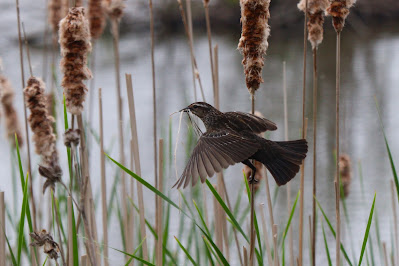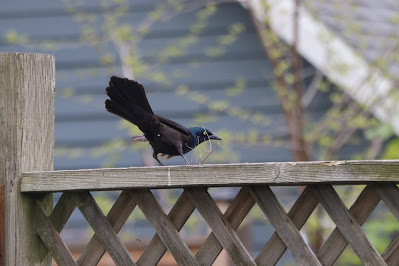Nesting Time!
Over the past several weeks, birds have been busy preparing for the next generation. Above, a Red-winged Blackbird female carries nesting material. She will weave a cup-like nest with grasses, suspended in and supported by plant material, often within the cattails.
Common Grackles typically nest high in coniferous trees between two vertical limbs or on a horizontal branch. They build a bulky cup made of twigs, leaves, and grasses and will use bits of paper, string, cloth, and corn husks. The female does most of the work and reinforces the nest cup with mud before lining it with fine grasses and horse hair.
https://www.allaboutbirds.org/guide/Common_Grackle/life history
A Flycatcher (sp) high in a tree, sitting on her nest.
A Baltimore Oriole sits above the beginnings of a nest. Males will bring material to the female, but the female does all the work in weaving the structure. The nest is built in three stages: First, the female weaves an outer bowl of flexible fibers to provide support. Next, springy fibers are woven into an inner bowl which maintains the bag-like shape of the nest. Finally, she adds a soft lining of downy fibers and feathers to cushion the eggs and young.
https://www.allaboutbirds.org/guide/Baltimore_Oriole/lifehistory
We watched a female American Redstart building her nest at the Pinery. It looks complete but she was flying in and out, preparing the finishing touches!
Common Grackles have been collecting insects and grubs to feed their already hatched young. There are 2 dragonflies in the beak of the bird in the lower picture.
While on a birding tour at McGregor Point Provincial Park this week, we found a Brown Creeper nest, tucked up high, under a loose piece of bark on a dead Ash tree! The bottom of the nest was just barely visible to us. The female takes a week or two to build the nest, while the male helps by bringing nesting material. She builds the frame of the nest by layering twigs and strips of bark. She uses insect cocoons and spider egg cases to stick those materials to each other and to the inner surface of the tree bark.
https://www.allaboutbirds.org/guide/Brown_Creeper/lifehistory
Two Brown Creepers are visible on the tree trunk. Food for their hungry offspring is visible in the beaks of both parents.









No comments:
Post a Comment